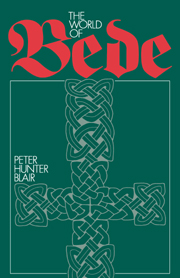Book contents
- Frontmatter
- Contents
- Foreword by Michael Lapidge
- Preface
- List of Abbreviations
- PART ONE ALTER ORBIS
- PART TWO TOWARDS CHRISTIANITY
- PART THREE THE GROWTH OF MONASTICISM
- 12 Gaulish and Italian Influences
- 13 Spanish Influences
- 14 Aspects of English Monasticism
- 15 Benedict Biscop's Early Years
- 16 The Foundation of Wearmouth
- 17 The Foundation of Jarrow
- 18 The Abbacy of Ceolfrith
- PART FOUR LEARNING, TEACHING AND WRITING
- Select Bibliography
- Index
14 - Aspects of English Monasticism
Published online by Cambridge University Press: 02 February 2010
- Frontmatter
- Contents
- Foreword by Michael Lapidge
- Preface
- List of Abbreviations
- PART ONE ALTER ORBIS
- PART TWO TOWARDS CHRISTIANITY
- PART THREE THE GROWTH OF MONASTICISM
- 12 Gaulish and Italian Influences
- 13 Spanish Influences
- 14 Aspects of English Monasticism
- 15 Benedict Biscop's Early Years
- 16 The Foundation of Wearmouth
- 17 The Foundation of Jarrow
- 18 The Abbacy of Ceolfrith
- PART FOUR LEARNING, TEACHING AND WRITING
- Select Bibliography
- Index
Summary
The monasticism of Italy, Spain and Gaul developed within the framework of a diocesan organisation which was itself based upon the still-surviving urban civilisation of the later Roman empire. In the far west and north of Britain there had never been any towns, and in those parts occupied by the English there were merely the remains of towns. It would be foolish to suppose that in the sixth and seventh centuries all the former towns of Roman Britain were falling into ruins and entirely without inhabitants. In a few cases — London, Canterbury, Rochester, York, Carlisle — we know that this was not so, but it seems certain that in none of these towns did any literate civilisation, whether secular or ecclesiastical, survive beyond the Roman occupation. Whatever gossamer threads of continuity there may have been, in this respect at least the break was complete. Augustine came to England from a monastery in Rome and when he built his own monastery in Canterbury no doubt there would be many Roman buildings still standing there, in addition to the two churches mentioned by Bede. He would find in Canterbury at least the semblance of a Roman town and if it had suffered damage during the Anglo-Saxon invasions, so had many of the Italian towns during the Lombard invasions.
- Type
- Chapter
- Information
- The World of Bede , pp. 139 - 154Publisher: Cambridge University PressPrint publication year: 1990



